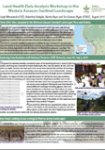Iniciativa de Monitoreo Socio-ecológico de la Amazonía Occidental (IMSAO) covers the tri-national frontier region of Madre de Dios and Ucayali (Peru), Acre (Brazil), and Pando (Bolivia). A broad range of development conditions can be found. Acre is situated further along the economic development x-axis (higher economic development) and further down the forest cover y-axis (smaller area of forest cover) of the forest transition curve than the other three locations. Pando, on the other hand, is placed highest on the downward slope of the curve, with the least economic development and most forest cover. Post-deforestation land-use trajectories also vary considerably, from degraded pasture lands, large areas of fallow and secondary forest, and oil palm plantations, to relatively diverse cocoa agroforestry.
The diversity in land use corresponds with a range of natural ecosystems, from highly diverse broad-leaved forest, through to grassland, shrubby riverine swamp, and bamboo forest to species-poor but carbon-rich Aguajales (Mauritia flexuosa). On a regional scale, the landscape is strikingly segregated with most remote sensing-based maps showing a clear agricultural frontier; yet at a finer scale the agricultural landscape is a mosaic. All of this variation is expected to generate differential delivery in the provision of ecosystem goods and services at the forest- and forest-agriculture interface, while in turn create tradeoffs in provision due to loss of taxonomic and functional diversity. Degraded lands across the proposed landscape offer considerable potential for enhancement of environmental services.
There are multiple options for achieving optimized outcomes for livelihoods and the environment across the landscape, as well as variable constraints and challenges to doing so. Within forest areas, there is high potential for multiple-use forest management of Brazil nuts and timber to promote forest conservation and regional livelihoods. There are also multiple subnational Reducing Emissions from Deforestation and Forest Degradation (REDD+) projects in the region, which are highly diverse in terms of scale, project proponents, local actors involved and interventions underway. Outside the forest, there are multiple opportunities both to mitigate environmental impacts of current practices (silvopasture, improved fallows, improved pastureland) and to shift degraded landscapes toward the “upward” section of the transition curve. Each potential option is associated with economic, policy, institutional (including markets and market chains), social and technical barriers. The search for optimized outcomes within the variety of local constraints offers rich learning possibilities and strong promise for transferability to other regions.
Ucayali, Peru
Forest within the Sinchi Roca indigenous community, legal timber production and illegal small-scale logging. Presence of coca fields, shifting cultivation and fallow-based systems, cocoa production and extensive livestock at the margin.
Madre de Dios, Peru
Intervened old growth forest, secondary forest, mining. Presence of degraded and improved agricultural and pasture land.
Pando, Bolivia
Presence of agroforestry systems (castaña). Low deforestation level and high conservation value areas.
| Framework |
|
• |
Development of a theoretical framework with partners to identify four relevant outcomes to research and the socioeconomic, institutional and biophysical conditions that enable them: sustainability, livelihoods, equity, multifunctionality |
|
| Institutional mapping |
|
• |
Development of protocols and tools for data collection: |
|
• |
Resource management rules (formal and informal) |
|
• |
Stakeholders that use or influence the rule-making processes |
|
• |
Processes by which rules are made and applied |
|
|
| Gender integration |
|
• |
Incorporation of a gender perspective into data collection tools |
|
Partnership building
|
• |
Establishment of a strong collaborative partnership with the Peruvian Amazon Research Institute (IIAP) for data collection activities in the two sites located in Peru: Ucayali and Madre de Dios |
|
• |
Establishment of a strong collaborative partnership with Cooperazione e sviluppo (CESVI) for data collection activities in the site located in Bolivia |
| Training and data collection |
|
• |
Training on LDSF and socioeconomic teams was conducted in August 2014 in Madre de Dios, with strong support from the Nicaragua-Honduras sentinel landscape team |
|
• |
Data collection started in September 2014 and is currently being done in Peru |
|

